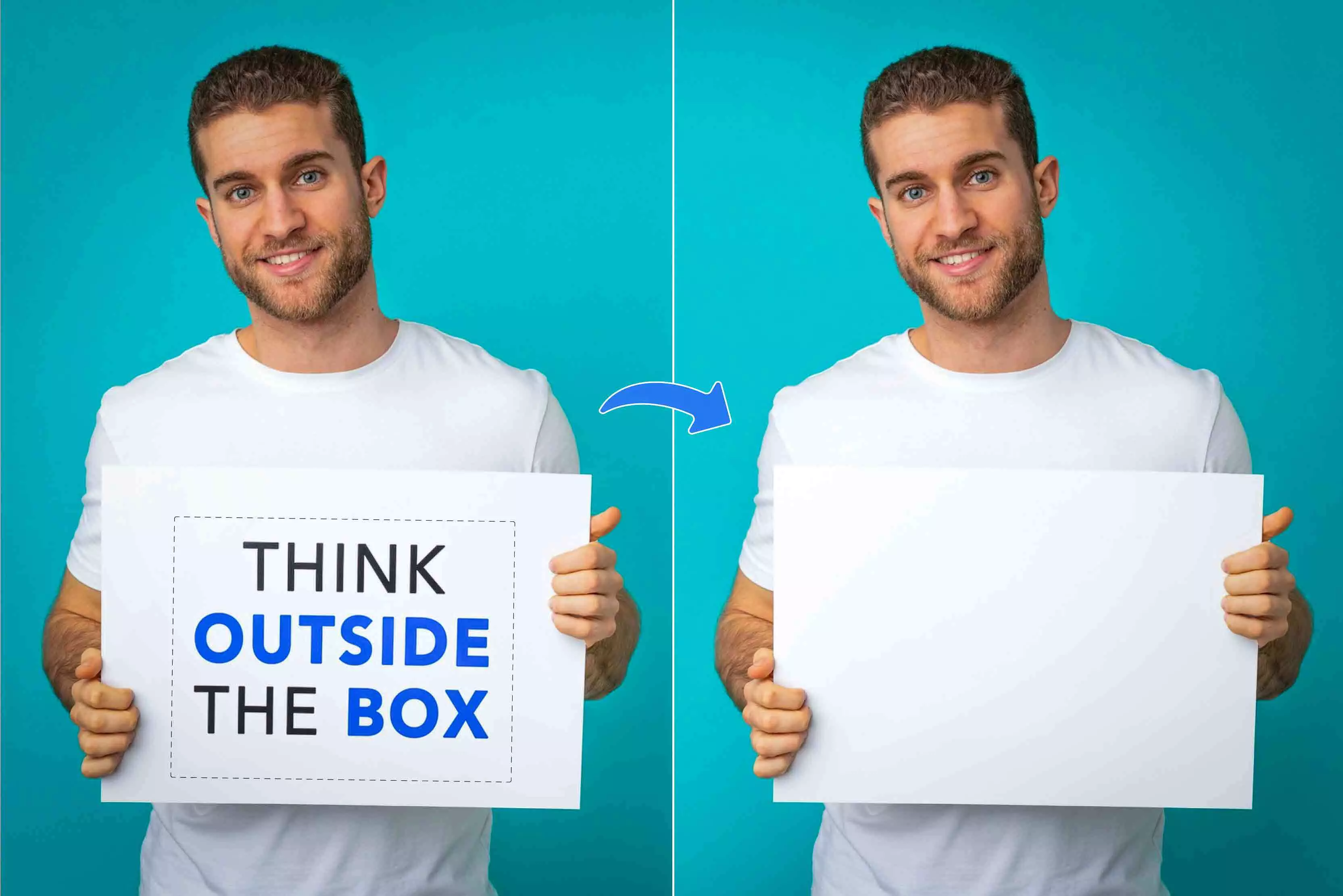Have you ever clicked a perfect photo only to realize there’s an unwanted date stamp in the corner? Or maybe you downloaded a beautiful image for a project, but a watermark is ruining the vibe.
Sometimes it’s an old family picture with a name written across it, and sometimes it’s just a meme template you want to reuse. People remove text from images for all kinds of practical reasons—watermarks, captions, dates, stickers, or app-generated text.
Earlier, fixing these issues meant hours of manual editing with clone tools and brushes, trying to blend every pixel perfectly. But AI tools have made the process simple and quick. They can recognize the background, fill in missing parts, and remove text fast—much faster and neater than old-fashioned methods.
In this blog, we’ll look at why people remove text from photos, how AI tools compare to manual editing, the best online tools you can use, and simple tips to get smooth, natural results. If you’ve ever struggled to clean up a picture, this guide will show you the easiest and most effective ways to do it.
Understanding AI-based text removal
Removing text from a picture used to be a slow, manual process. But with AI, the method is completely different—and far more advanced. Modern tools use a technique called AI inpainting, which doesn’t just cover the text; it actually recreates the missing background.
AI analyzes the areas around the text to understand:
- Colors
- Textures
- Patterns
- Lighting
- Depth
Based on this information, it predicts what the hidden background should look like and then rebuilds it pixel by pixel. The result is a clean, natural-looking area that blends perfectly with the rest of the image.
AI-based removal offers several practical benefits:
- Speed: The process takes seconds instead of minutes.
- Natural results: AI maintains consistent lighting and texture for a seamless look.
- Beginner-friendly: No advanced photo-editing skills are required.
- Less manual work: No need to clone, brush, or guess what the background might be.
10 Popular online tools to remove text using AI
In this section, I have listed the top 10 online tools that help remove text from images. Here, I have used only one image in all the tools, and all of them have really generated amazing results. Most of them offer free trials to users. Try them out one by one.
1. Pixelbin
Pixelbin offers a smooth and reliable one-click text removal feature that quickly clears unwanted words from any image. The AI automatically detects the text area and reconstructs the background so naturally that the edit blends in without visible marks. A user has to upload the image, and the tool will do the rest. Below, I have shown the steps on how to remove text from an image using Pixelbin.
PixelBin is a full AI image editing tool that can do more than just remove text. It can also clean up watermarks, remove backgrounds, erase objects, and much more. Its API also makes sure that bulk processing is quick and easy when working with more than one image.
Steps to remove text from an image using Pixelbin
Step 1: Visit the official website and click on AI tools > See all.
Step 2: Search for “Remove text from images online.”
Step 3: You will be navigated to another page. Upload the image from which you want to remove text.
Step 4: Below, you can set the difference between before and after the image.
2. LightX Editor
LightX’s AI Text Remover erases words from photos using automatic detection; its inpainting fills backgrounds so edits read naturally. Once marked, the “Remove” option erases the text and blends the area naturally.
Along with text removal, LightX also offers tools like watermark remover, object eraser, background remover, AI generative expand/replace, upscaling, and mobile app support for quick editing.
There’s also an AI expander (to “Uncrop” or enlarge scenes), upscaling, generative fill/replace, and even creative tools like avatar and background generation. Overall, LightX is a versatile, AI-driven photo editor usable in-browser or on mobile.
Steps to remove text from an image using LightX Editor
Step 1: Visit the official website and sign up. Click on photo editor tools > see all.
Step 2: Scroll down and click on the option “Remove text from image.
Step 3: Upload the image.
Step 4: Click on “Remove text.”
Step 5: Below, you can see that the tool has removed the text from the image.
3. Krea.ai
Krea.ai removes text from images primarily through prompt-based editing: users type natural-language instructions (for example, “remove the caption”) and the platform’s AI inpaints the area, so no manual brushing is required.
The editor accepts common formats (PNG, JPG, WEBP, HEIC/AVIF) and can remove captions, overlays, or unwanted labels using generation-based transforms. Beyond text removal, Krea offers object removal (brush optional), generative fill/outpainting, background replacement, image enhancement and upscaling, plus multi-model text-to-image generation.
The platform supports collaborative workspaces, an online editor, and export options, making it suitable for quick fixes and creative production workflows, and has free and paid plans available.
Steps to remove text from an image using Krea.ai
Step 1: Visit the official website and click on the “Edit” icon.
Step 2: Upload the image.
Step 3: After uploading the image, write a prompt about what you want to do with it.
Step 4: Below, you can see that the tool has removed the text from the image.
4. ChatGPT
ChatGPT helps remove text from images through its DALL-E editing (inpainting) feature. You can upload an image, mark the area containing text, and simply prompt, “remove the text and fill the background naturally.”
ChatGPT then recreates that section smoothly so the edit looks clean. Beyond text removal, it also supports object removal, object addition, background changes, style transformations, image enhancement, and full image generation from prompts.
You can also ask ChatGPT to improve, expand, or restyle any generated or uploaded image. Overall, it works like an AI-powered smart editor where you describe what you want, and it handles the visual edits for you.
Steps to remove text from an image using ChatGPT
Step 1: Visit the official website and click on the “+” icon.
Step 2: Upload the image and write the prompt on what you want to do with the image.
Step 3: Below, you can see that it has removed the text from the image.
5. Google Gemini
Google Gemini now supports text-prompt–based image editing, allowing you to remove or modify parts of an image—including text—just by describing what you want changed. With Gemini 2.5 Flash Image, you can inpaint sections conversationally, meaning you don’t need to mask areas in every scenario manually.
Beyond removing text, Gemini lets you change backgrounds, add or remove objects, and adjust styles in multiple steps. It integrates with Google Photos too: you can ask Gemini to edit your photos using simple voice or text prompts.
Steps to remove text from an image using Google Gemini
Step 1: Visit the official website and click on the “+” icon.
Step 2: Upload the image and write the prompt on what you want to do with the image.
Step 3: Below, you can see that, as per my given prompt, the tool has removed the text from the image.
6. Cleanup.pictures
Cleanup.pictures is an AI tool that works on the web and lets you get rid of text, people, things, and flaws from pictures by simply brushing over the part you don't want. Then, its inpainting technology fills in gaps in the background in a way that looks natural. You can change the size of the brush to choose the exact areas you want.
The free plan lets you export up to 720p, but the Pro (paid) plan lets you make edits at higher resolutions. Cleanup.pictures also has an API that lets developers add its object-removal features to their own apps.
Steps to remove text from an image using Cleanup.pictures
Step 1: Visit the official website and click on “Click here or drag an image file.”
Step 2: Choose the quality of the image. Here, I have chosen “Continue with SD.”
Step 3: Choose the “Eraser option” and apply it to the text area.
Step 4: Just after applying the eraser, the tool will remove the text from the image.
7. Canva
Canva makes removing text from an image simple with its Text Remover feature available under the Photo Editing tools. After uploading your image and clicking Edit Photo, you can choose the AI-powered text removal option, which detects the text area and clears it with a single click.
Canva’s Generative Fill automatically rebuilds the background so the erased space looks natural, without needing manual brushing or advanced editing skills.
Other AI-driven features include Magic Expand (to enlarge or “outpaint” a scene), Magic Grab (to isolate and reposition objects), Grab Text (to extract and edit text from images), Magic Media (text-to-image generation), and Magic Write (AI writing assistant).
Steps to remove text from an image using Canva
Step 1: Visit the official website and sign up. Click on the three dots on the left side and then click on “Apps.”
Step 2: Under All apps, click on “Photo editing” then “text remover.”
Step 3: Click on “Use in new design.”
Step 4: Select the option for what you would like to create.
Step 5: Upload the file.
Step 6: Click on “Remove text.”
Step 7: Below, you can see the result.
8. Picsart
Picsart makes it really easy to remove text from pictures using its AI-powered Object Remover. You upload your image, pick the “Remove” tool, and brush over the text you want to erase—Picsart’s AI then fills in the background to make it look natural.
Besides text removal, Picsart gives you other powerful features: you can remove people or watermarks, clone parts of your image, or restore slightly erased areas using a “Restore” brush. It also offers AI generation tools, background editing, filters, and a full set of creative design options.
Steps to remove text from an image using Picsart
Step 1: Visit the official website and sign up. Click on “Create” and then “More tools.”
Step 2: Click on “AI image editor.”
Step 3: Upload the image and write the prompt.
Step 4: The tool has edited the image as per the prompt.
9. Fotor
Fotor makes removing text from images very easy with its Magic Remove tool. After uploading an image, you just brush over the text and click the remove button—Fotor’s AI instantly clears the selected area and rebuilds the background so it looks smooth and natural. The results are quite clean, even on textured surfaces.
Fotor has a lot of useful features, such as the Clone tool for precise touch-ups, AI inpainting to fill in missing details, and watermark or object removal for more complicated edits.
Steps to remove text from an image using Fotor
Step 1: Visit the official website and sign up. Click on the “AI photo.”
Step 2: Click on “AI photo editor.”
Step 3: Upload the image.
Step 4: Choose the “Magic eraser.”
Step 5: Apply to the text area and click on “Remove.”
Step 6: Below, you can see that the tool has removed the text from the image.
10. SnapEdit
SnapEdit lets you remove text from an image using a simple lasso selection process. After uploading your photo, you choose the Object Removal tool and use the lasso to draw around the text you want to erase.
Once the area is selected, you click Remove, and SnapEdit’s AI automatically cleans the text and reconstructs the background so the edited part blends naturally.
This makes it useful not only for text removal but also for clearing logos, watermarks, stickers, or unwanted objects. SnapEdit also includes tools for background removal, photo enhancement, face retouching, sky replacement, and restoring old or low-quality images.
Steps to remove text from an image using SnapEdit
Step 1: Visit the official website and click on AI products > Remove text.
Step 2: Upload the image.
Step 3: Select “Lasso.”
Step 4: Apply it over the text area and tap on “Remove.”
Step 5: The tool will remove the selected text area from the image.
Tips for getting better results
AI tools make it easy to remove text, but doing a few extra things can help you get even cleaner, more professional-looking pictures.
1. Be precise when selecting the text area
Select only the area where the text is. A light selection helps the AI know what it should remove and what it should not touch. If you select too much, the AI may change parts of the picture that you want to keep.
2. Use negative selection if the tool offers it
Some AI editors let you choose "Negative" or "Protect" as an option. You can use this to tell the AI not to change some parts, like a person’s face or key design details. This feature makes sure the AI only removes the text and leaves everything else unchanged.
3. Choose the right quality mode
AI has made it a lot easier to take text out of pictures. It uses a smart method called inpainting, which doesn't just cover the text; it also rebuilds the background so that the picture looks real.
4. Fix small errors or artifacts. acts
The AI looks at the text and the colors, patterns, and details around it. Then it tries to guess what the hidden background should look like and makes it pixel by pixel. Because of this, the part that was changed fits in with the rest of the picture.
Conclusion
After trying and exploring different tools like Pixelbin, Fotor, Pixlr, LightX, Cleanup, pictures, and other AI editors myself, one thing is clear—removing text from images has become incredibly simple.
Each tool handles text removal differently, but AI inpainting is what truly makes the process smooth and natural. Whether it is a watermark, caption, date stamp, or random text, AI rebuilds the background in a way that looks real, not edited.
With careful selection, the right quality mode, and a few small fixes, you can get clean and natural results even when the background is difficult. If you want quick, neat, and high-quality images without text, the AI tools I explored make the job much easier than traditional editing ever could.
FAQs
Use tools that offer content-aware fill or AI-based removal. These tools analyze surrounding pixels and blend the removed area naturally. Avoid over-blurring or excessive cloning to maintain quality.
Free tools like Pixelbin, Fotor, Pixlr, and Cleanup are popular options for pictures. They offer quick AI-powered text removal without requiring advanced editing skills.
Yes, many AI tools can handle complex backgrounds. They study patterns, textures, and colors to reconstruct the hidden area, although the results may vary depending on the image.
Absolutely. Apps like Snapseed, PicsArt, and LightX offer text-removal features directly on mobile devices. You can erase or heal the area with just a few taps.
Removing text or watermarks from copyrighted images is generally not allowed unless you own the image or have permission. Watermarks protect the creator’s rights.
Try refining the edit using tools like clone stamp, heal brush, or AI retouch. You can also adjust texture, sharpness, or add light grain to make the area blend better with the rest of the image.










